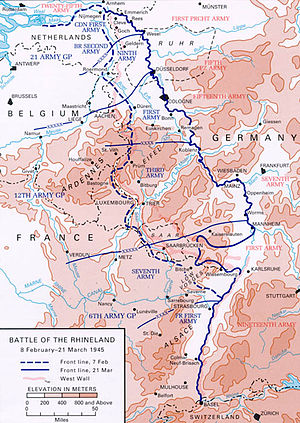- Operation Lumberjack
-
Operation Lumberjack Part of the Western Front of World War II 
Date 1-7 March 1945 Location Germany Result Allied victory Belligerents  United States
United States Germany
GermanyCommanders and leaders  Omar Bradley
Omar Bradley Walter Model
Walter ModelOperation Lumberjack was a military operation conducted in the last stages of the war in Europe during World War II. It was launched by the First United States Army in March 1945 to capture strategic cities in Germany such as Cologne, and to give the Allies a foothold along the Rhine River.
With the 21 Army Group firmly established along the Rhine, Bradley's 12th Army Group prepared to execute Operation LUMBERJACK. General Omar Bradley's plan called for the U.S. First Army to attack southeastward toward the juncture of the Ahr and Rhine Rivers and then swing south to meet Patton, whose U. S. Third Army would simultaneously drive northeastward through the Eifel. If successful, LUMBERJACK would capture Cologne, secure the Koblenz sector, and bring the 12th Army Group to the Rhine in the entire area north of the Moselle River. The 12th Army Group also hoped to bag a large number of Germans.
During the operation, the U.S. First Army controlled the III, V, and VII Corps. III Corps had the 9th Armored Division and the 1st, 9th, and 78th Infantry Divisions attached. V Corps had attached the 2nd, 28th, 69th, and 106th Infantry Divisions attached as well as the 7th Armored Division, although the 7th was not committed to the operation and had transferred to the III Corps by March 7th. The VII Corps controlled the 3rd Armored Division and the 8th, 99th, and 104th Infantry Divisions.[1] From north to south, the attacking U.S. forces were confronted by the LXXXI (9th and 11th Panzer Divisions, and the 476th, 363rd, and 59th Infantry Divisions) and LVIII Panzer Corps (353rd and 12th Infantry Divisions, as well as the 3rd Panzergrenadier Division) of the German Fifteenth Army, and the LXXIV (85th and 272nd Infantry Divisions, as well as the 3rd Airborne Division), LXVII (89th and 277th Infantry Divisions), and LXVI Corps (5th Airborne Division) of the German Fifth Panzer Army.[2]
Bradley launched LUMBERJACK on 1 March. In the north, the First Army rapidly exploited bridgeheads over the Erft River, entering Euskirchen on 4 March and Cologne on the fifth. Simultaneously, the Third Army swept through the Eifel to the Rhine.
The distance advanced by U.S. units during LUMBERJACK varied between about 10 to 40 miles. In the north, the U.S. VII Corps advanced to the banks of the Rhine River in Cologne, while its neighbor to the south, III Corps, advanced to positions near Bonn and into Remagen. Further south, the V Corps pushed about 10 to 20 miles into the High Eifel.
In the First Army area, a task force of the 9th Armored Division—commanded by Lt. Col. Leonard Engeman—advanced toward Remagen as part of the LUMBERJACK offensive. As the armored task force reached the edge of the city, it discovered that the Ludendorff railroad bridge over the Rhine was, surprisingly, still standing. Engeman attacked and, although the German defenders attempted to destroy the span, took the bridge on 7 March.
The Allies finally had a bridgehead on the Rhine. In the Battle of Remagen over the coming days, the Germans tried desperately to destroy the bridge, but to no avail. Eisenhower told Bradley to push five divisions across the Rhine to secure the bridgehead, but he did not let the 12th Army Group take immediate advantage of the opportunity offered. Instead, on 13 March, Eisenhower ordered Bradley to limit the expansion of the Remagen bridgehead to a maximum width of 25 mi (40 km) and a depth of 10 mi (16 km), lest it detract from the main effort by the 21 Army Group.
Although the Ludendorff bridge collapsed on 17 March, the Allies had built several pontoon bridges across the Rhine by then and had a strong bridgehead on the east shore.
Contents
See also
References
Attribution
 This article incorporates public domain material from the United States Government document "Rhineland, 15 September 1944 – 21 March 1945".
This article incorporates public domain material from the United States Government document "Rhineland, 15 September 1944 – 21 March 1945".Other sources
- Charles MacDonald, The Last Offensive, Washington: GPO, 1973.
- Georg Tessin, Verbände und Truppen der deutschen Wehrmacht and Waffen-SS 1939 - 1945, Volume 2, Osnabrück:Biblio Verlag, 1973.
- Georg Tessin, Verbände und Truppen der deutschen Wehrmacht and Waffen-SS 1939 - 1945, Volume 4, Osnabrück:Biblio Verlag, 1975.
External links
- The Rhineland Campaign
- MacDonald's The Last Offensive online at www.ibiblio.org
- Map of Operation Lumberjack - [1]
Categories:- World War II operations and battles of the Western European Theatre
- Military operations of World War II involving Germany
- Battle of Central Europe
- Battles and operations of World War II involving the United States
- World War II stubs
Wikimedia Foundation. 2010.
